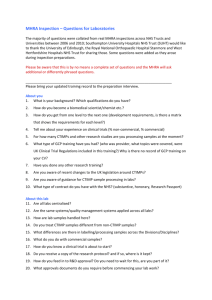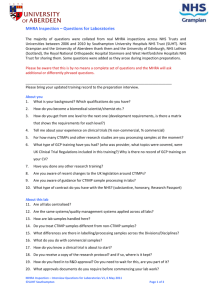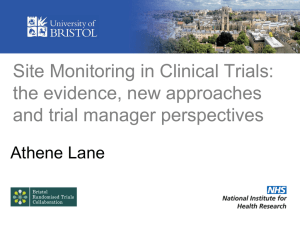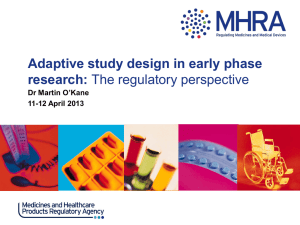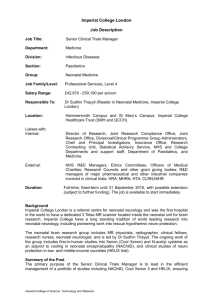Clinical Trials Regulation
advertisement
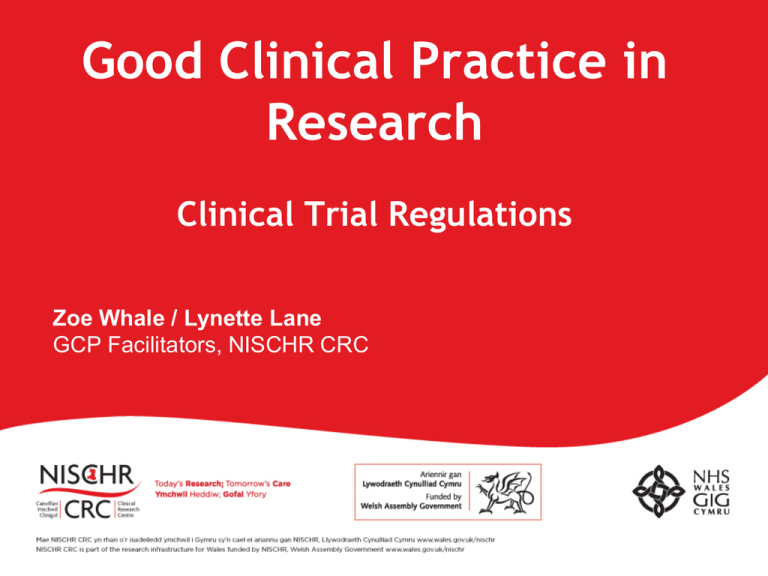
Good Clinical Practice in Research Clinical Trial Regulations Zoe Whale / Lynette Lane GCP Facilitators, NISCHR CRC Objectives At the end of this session, I hope you will be able to: •Understand there is a set of interwoven laws, guidelines and frameworks which govern the set up and conduct of clinical research • Understand what CTIMP and non-CTIMP studies are, the differences between them and the regulatory requirements which govern their conduct •See GCP as a ‘live’ subject which is about continually improving the way things are done •Share your experiences of applying GCP to your own research field What is the significance of regulation and standards in clinical research? • Safeguard and protect research subjects • Risk reduction • Quality data/outcomes • Excellent research, good science Examples Can anyone give me examples of ‘bad’ or ‘poor’ research? Standards in Research are not new Ethical standards to protect people have been around for over 60 years Research Governance Framework for Health and Social Care in Wales 2009 • The framework applies to all research that relates to the responsibilities of the Secretary of State for Health • “… research concerned with the protection and promotion of public health, research undertaken in or by the Department of Health, its non Departmental Public Bodies and the NHS, and research undertaken by or within social care agencies. It includes clinical and non-clinical research” The framework is not law but must be adhered to for all studies conducted in Wales EU Legislation UK Legislation ‘Guidance’ EU Clinical Trials Directive 2001/20/EC Medicines for Human Use (Clinical Trials) Regulations 2004 (SI 1031) EC Commission Eudralex – Volume 10 Clinical Trial guidelines EU GCP Directive 2005/28/EC Medicines for Human Use (Clinical Trials) Amendment Regulations 2006 (SI 1928) ICH GCP Topic E6 – Good Clinical Practice Amendment 2006 (SI 2964) Amendment 2008 (SI 941) Research Governance Framework for Health and Social Care Amendment 2009 (SI 1164) Organisation/Sponsor SOPs Amendment 2010 (SI 1882) What is all the fuss about? • Prior to 2004 the standards were guidelines and dual standards existed • For the first time ethical and scientific standards for the set up, and conduct of clinical research involving human subjects receiving investigational medicinal products, became subject to law European Directives & UK Laws • EU Directives are legislation issued by the European Union defining an outcome or change that is binding for each member state • EU Directives must be transposed into law in each member state to become law in that country • In the UK this is achieved by the introduction of a Statutory Instrument named within an Act of Parliament, which then becomes the law European Clinical Trials Directive 2001/20/EC • Introduced to ensure that everyone follows the same GCP standards • Clarified and standardised practice for the safety of the subject and the quality of the data • Refers to the Core Principles of ICH GCP (as a scientific guideline), especially Principles 5,7,11,12 and 13 • Major areas of change included: - The ethics review system came under the law - Each member state had to appoint a Competent Authority (MHRA in UK) - Strengthened consent for vulnerable groups - Amendments required to follow a process - Additional safety reporting requirements - All results have to be made available even if negative findings were found GCP principles are a standard for the design, conduct, performance, monitoring, auditing, recording, analyses and reporting of clinical trials that provides assurance that the data and reported results are credible and accurate, and that the rights, integrity and confidentiality of trial subjects are protected Imagine you have been asked to participate as a subject in a clinical study or trial What would you want to know about the study and the people involved in its conduct before taking part? GCP elements : MHRA inspection areas Trial initiation, approvals and completion Responsibilities of organisations and individuals Recruitment and informed consent processes, Documentation and data quality Safety reporting /pharmacovigilance Medicines for Human Use (Clinical trials) Regulations 2004 • Statutory Instrument 2004/1031 • Transposed European Clinical Trials Directive 2001/20/EC into UK Law from 1 May 2004 • Made amendments to the Medicines Act 1968 which regulated the supply of medicines for a clinical trial, but did not cover standards of conduct on a clinical trial • SI 2004/1031 regulates the commencement and conduct of a clinical trial and the manufacture of medicinal products to be used (including placebo) European Clinical Trials Directive 2005/28/EC • The second EU Directive clarified and extends the first • Major areas of change included: - Duties can be delegated, but not responsibilities - New requirements on sponsor and investigators in relation to Trial Documentation - Notification of serious breaches Statutory Instrument 2006/1928 • Transposed European Clinical Trials Directive 2005/28/EC into UK Law from 29 August 2006 • Makes amendments to the Medicines for Human Use (Clinical Trials) Regulations 2004 UK Regulations There have also been subsequent Statutory Instruments which govern the conduct of clinical research in the UK. The Statutory Instruments are: • 2004/1031 (1 May 2004) – EU Directive 2001/20/EC transposed into law • 2006/1928 (29 August 2006) – EU Directive 2005/28/EC transposed into law • 2006/2984 (12 December 2006) – A&E trials without consent for adults without capacity • 2008/941 (1 May 2008) – Research Ethics Committee membership and approval • 2009/1164 (8 May 2009) – Urgent safety measures • 2010/1882 (19 August 2010) – Advanced Therapy Medicinal Products All are available on the MHRA website www.mhra.gov.uk In addition … Researchers work within other guidelines and laws, including • • • • • • • Data Protection Act (1998) Protection of Children Act (1999) Mental Capacity Act (2005) Human Tissue Act (2004) Equality and Diversity Legislation Freedom of Information Act (2000) Welsh Language Act 1993/ 2011 • Health Board Policies Some update areas 2010 e-SUSAR reporting to MHRA : expedited safety reporting 2010 public consultation on proposals for amending adverse reaction reports (CT3) 2010 Academy of Medical Sciences Review – recommendations to streamline bureaucracy and reduce costs 2011 the DSUR (Development Safety Update Report) will replace the Annual Safety Report 2011 MHRA develops risk-adapted approaches to approvals, monitoring and inspection CTIMPS and Non-CTIMPS • A Clinical Trial of an Investigational Medicinal Product (CTIMP) is a legal definition and describes those trials which fall within the scope of the Medicines for Human Use (Clinical Trials) Regulations 2004 • Non-CTIMPS are studies which do not use IMPs as defined by the Medicines and Healthcare products Regulatory Agency (MHRA) The rules governing medicinal products in the European Union • Guidance documents on the MHRA website includes an algorithm to help you decide whether your study is a CTIMP or non-CTIMP CTIMP and Non CTIMP Requirements CTIMPs Non-CTIMPs • Must identify a sponsor • Must identify a sponsor • Require a favourable ethical opinion from a research ethics committee • Require host (R&D) approval to conduct the study • Must maintain a study master file • Must receive consent from the volunteer • Must collect accurate data • Must create a clear audit trail • Must be aware of the safety reporting requirements • Must conduct the study to Good Clinical practice guidelines • Must demonstrate financial transparency • Must be adequately funded • Require a favourable ethical opinion from a research ethics committee • Require host (R&D) approval to conduct the study • Must maintain a study master file • Must receive consent from the volunteer • Must collect accurate data • Must create a clear audit trail • Must be aware of the safety reporting requirements • Must conduct the study to Good Clinical practice guidelines • Must demonstrate financial transparency • Must be adequately funded CTIMP and Non CTIMP Requirements CTIMPs • Are governed by law and come under the jurisdiction of the UK competent authority: Medicines and Healthcare products Regulatory Agency (MHRA) • Must receive a Clinical Trials Authorisation • Must register for a EudraCT number (European Clinical Trials Database) • Are subject to mandatory inspections • Introduced Good Manufacturing Practice Non-CTIMPs • Are governed by the NHS Research Governance Framework In summary … • We have standards to protect research participants and data quality • In health and social care research in Wales, we work to the standards set out in: - Research Governance Framework for Health and Social Care (2009) - Statutory Instruments for CTIMPs brought into law through the Medicines for Human Use (Clinical trials) Regulations 2004 • A set of interwoven frameworks, guidelines and laws govern the setup and conduct of health and social care research • Requirements for CTIMP and Non-CTIMP studies are largely the same, with some additional requirements for CTIMPs Thank you - Any Questions?
